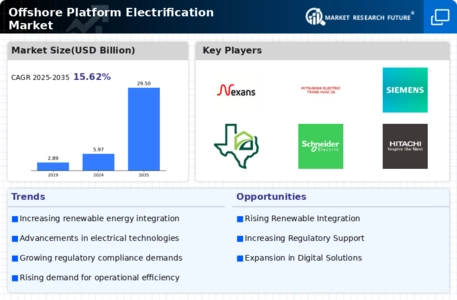Regulatory Support for Electrification
The Offshore Platform Electrification Market is experiencing a surge in regulatory support aimed at reducing carbon emissions and promoting sustainable practices. Governments are increasingly implementing stringent regulations that mandate the electrification of offshore platforms to minimize environmental impact. This regulatory framework not only encourages investment in electrification technologies but also fosters innovation in energy efficiency. For instance, policies that incentivize the use of renewable energy sources for offshore operations are becoming more prevalent. As a result, companies are likely to invest in electrification solutions that comply with these regulations, thereby driving growth in the Offshore Platform Electrification Market. The anticipated increase in regulatory compliance costs may further compel operators to transition towards electrified systems, enhancing operational efficiency and sustainability.
Economic Viability of Electrification Projects
The economic viability of electrification projects is a crucial driver for the Offshore Platform Electrification Market. As the costs associated with renewable energy technologies continue to decline, electrification becomes a more attractive option for offshore operators. The decreasing costs of solar panels, wind turbines, and energy storage systems are making it feasible for companies to invest in electrification solutions that were previously considered economically unviable. This trend is likely to encourage more operators to transition to electrified systems, thereby expanding the Offshore Platform Electrification Market. Additionally, the potential for long-term cost savings through reduced fuel consumption and maintenance expenses further enhances the economic appeal of electrification projects. As operators recognize the financial benefits, the market is expected to grow steadily.
Rising Demand for Sustainable Energy Solutions
The Offshore Platform Electrification Market is witnessing a rising demand for sustainable energy solutions driven by the global shift towards decarbonization. As stakeholders increasingly prioritize environmental responsibility, the need for electrification of offshore platforms becomes more pronounced. This demand is further fueled by the growing awareness of climate change and its impacts on marine ecosystems. Companies are now seeking to implement electrification strategies that not only comply with environmental regulations but also enhance their corporate social responsibility profiles. The Offshore Platform Electrification Market is likely to see a significant uptick in investments as operators strive to meet this demand for sustainable practices. The transition to electrified systems is expected to reduce greenhouse gas emissions and improve the overall sustainability of offshore operations.
Increased Investment in Offshore Infrastructure
Increased investment in offshore infrastructure is significantly influencing the Offshore Platform Electrification Market. As countries seek to enhance their energy security and reduce dependence on fossil fuels, there is a concerted effort to develop and upgrade offshore facilities. This investment trend is likely to encompass electrification initiatives, as operators recognize the need for modernized infrastructure that supports sustainable energy practices. The Offshore Platform Electrification Market stands to benefit from this influx of capital, as it enables the deployment of advanced electrification technologies and systems. Furthermore, the expansion of offshore wind farms and other renewable energy projects is expected to create additional opportunities for electrification, thereby driving growth in the market. The synergy between infrastructure investment and electrification initiatives is likely to shape the future landscape of offshore energy operations.
Technological Advancements in Electrification Solutions
Technological advancements play a pivotal role in shaping the Offshore Platform Electrification Market. Innovations in power generation, storage, and distribution technologies are enabling more efficient and reliable electrification solutions for offshore platforms. For example, the development of advanced battery systems and smart grid technologies is facilitating the integration of renewable energy sources into offshore operations. These advancements not only enhance the reliability of power supply but also reduce operational costs. The Offshore Platform Electrification Market is likely to benefit from the increasing adoption of these technologies, as they provide operators with the tools necessary to optimize energy consumption and reduce reliance on fossil fuels. Furthermore, ongoing research and development efforts are expected to yield even more efficient electrification solutions in the near future.


















Leave a Comment